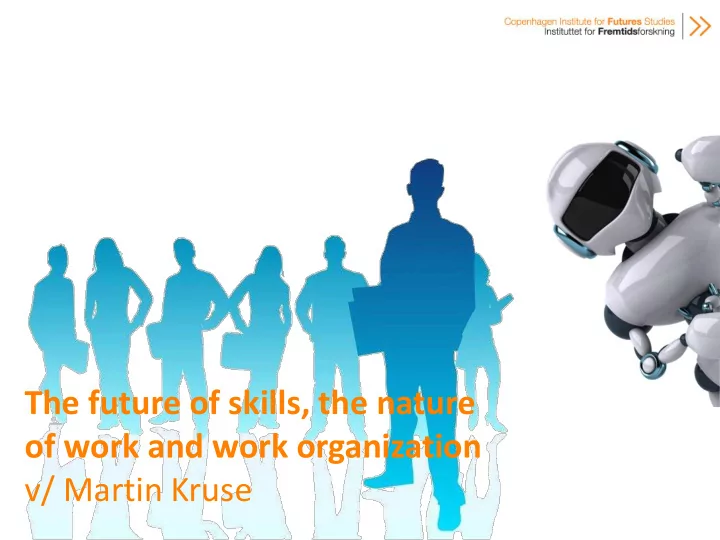

The future of skills, the nature of work and work organization v/ Martin Kruse
Copenhagen Institute for Futures Studies • Private independent think tank • Strategy, risk analysis, early warning, inspiration, hotline • CPH, Oslo, Brussels, Stavanger, Sao Paulo • Clients/members: Municipalities, multi- nationals, governments, intergovernmental organisations - Global scanning review
"Software substitution, whether it's for drivers or waiters or nurses … it's progressing. ... 20 years from now, labor demand for lots of skill sets will be substantially lower. I don’t think people have that in their mental model." Bill Gates
Automation has happened before Skills: From muscles to brains
Organizational and individual capabilities Foster resilience Source: CIFS, 2016.
Why a goldfish does not need resilience
Why is it so hard? Resilience in action 1. Wrong toolbox 2. Complexity 3. Short-termism 4. Wishful thinking 5. Incentive alignment Source: CIFS, 2016.
Organizational alignment • Aligmenent of structur and culture • Culture = (hopes, dreams, ambitions, aspirations and a lot of history) Culture defines recruitment and organizational structure • = Organizational structure is often more a match to culture than a fit • for purpose • Culture eats strategy for breakfast
Perception of Change Present Future Past ”I believe it when I see ”Forward people ” ”The good old days ” it” ”We see the world as we are , not like the world is…” ”The future is worrying…” Source: CIFS, 2016.
Skills • Modeling skills • From repetitive work (same same) to adaptive (personal Technology change management, just in time learning) • Cultural impact understanding • Creativity • Cross Cultural Competencies Globalization • Empathy Longevity • Life long learning • Trans disciplinary • Social intelligence, Warm hands Source: CIFS, 2017.
What computers cannot do 3 D printing can create a plane
Management by data: New Public Management 2.0 • People analytics can create a better work environment… • Highlight ineffencies: employees spend almost no time collaborating, but more than 25 % of their time in meetings in which their presence is not crucial. • Execution problems in real-time. • Talent recruitment from top universities to inside from specific departments. But…” I feel I cannot do a quality job due to time pressure needed to measure success.” • Data interpretation lack context • Who needs trust, when you’ve got data
-- or destroy employee engagement
-- How to destroy the creative climate • Time pressure • Fear • Internal competition • Financial rewards • Layoffs and restructuring • Waiting to innovate
Creative Public sector Bureaucracy, clear hierarchy Freedom and centralized decision making and formalized rules Risk appetite Desire to know the results in advance: Innovation has a chance of failure Leaders in public sector is trained in spotting problem and take care of them before they develop
Rutine job will be removed from public sector Social • Loose the not invented Experimentation here syndrome • Managing crosscutting problems Silothinking • • From input to outcome
Change is coming Don’t be the Goldfish!
Recommend
More recommend